#Silenus
Text
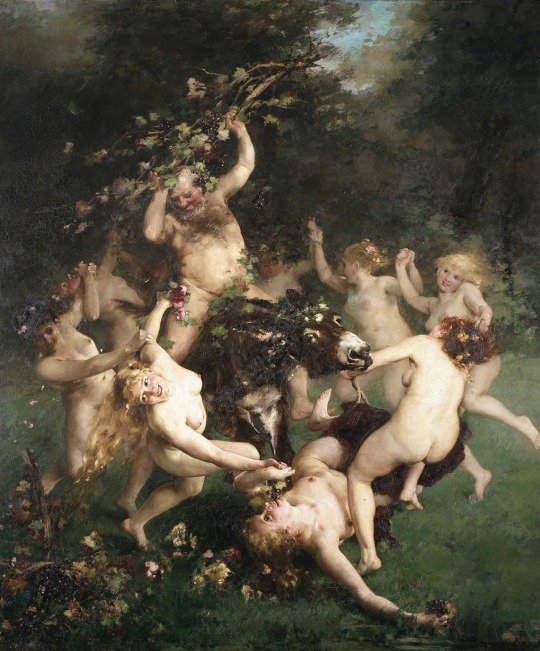
The Feast of Silenus by Alfred Philippe Roll (1871)
#alfred philippe roll#art#paintings#fine art#19th century#19th century art#academicism#academism#academic art#painting#french art#french artist#mythology#greek mythology#silenus#bacchante#maenad#classic art
4K notes
·
View notes
Photo

Mirror frame "Dionysus Procession". Wood carving.
#archaic ancient crafts history panel primitive pyrography traditionalart woodworking historyart#woodworking#woodcarving#arts and crafts#crafts#handmadeartwork#handmade#arts#dionysus#antiquity#ancient greece#mythologyart#mythology#centaur#silenus#faun#satyr#artists on tumblr#tumblr artist#artisan crafts#український tumblr#mirror frame#peacock
161 notes
·
View notes
Text
OKAY so I read "The Caesars" by emperor Julian and y'all, if you love Lucian's satires this is absolutely for you.
Here are some of my favorite parts from it:
A quick summary: Romulus (who has now attained the status of a god, like Heracles) once hosted a Saturnalia and invited the Greek gods and the Roman emperors to the banquet. A contest between the Roman emperors ensued, with Alexander the Great called in as an extra contestant upon Heracles' request.
Silenus is the star of the show, doing most of the jesting. But I really like the way his bond with Dionysus is highlighted

And it's no joke, he really does roast these emperors till they're sizzling lol starting with Julius Caesar himself:
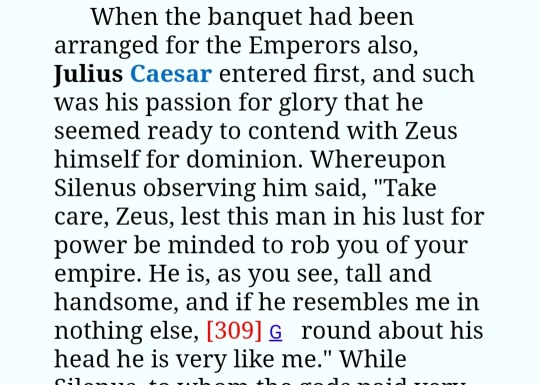
Next comes Augustus Octavius, whose entry is so pretentious and pompous that it becomes repulsive
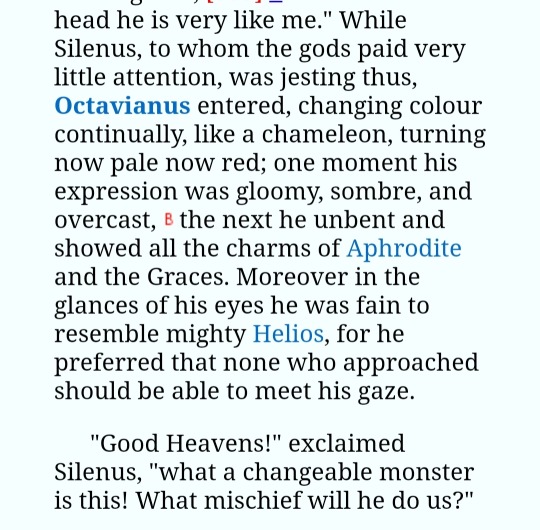
Apollo gets a bit defensive over his "nursling" (a nod to the belief that Octavius was actually Apollo's son) and goes *insert Barbie meme "it's really not that bad! it just needs a little... shaping. To the salon!!"* ft Zenon the Philosopher who casts some spells of philosophy to make Octavius less obnoxious
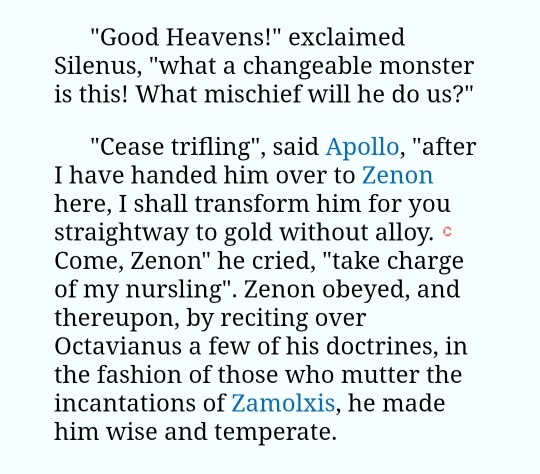
And it works because Octavius is mostly humble and well mannered for the rest of the day lol
Heracles grabs this opportunity to fanboy over Alexander the great.
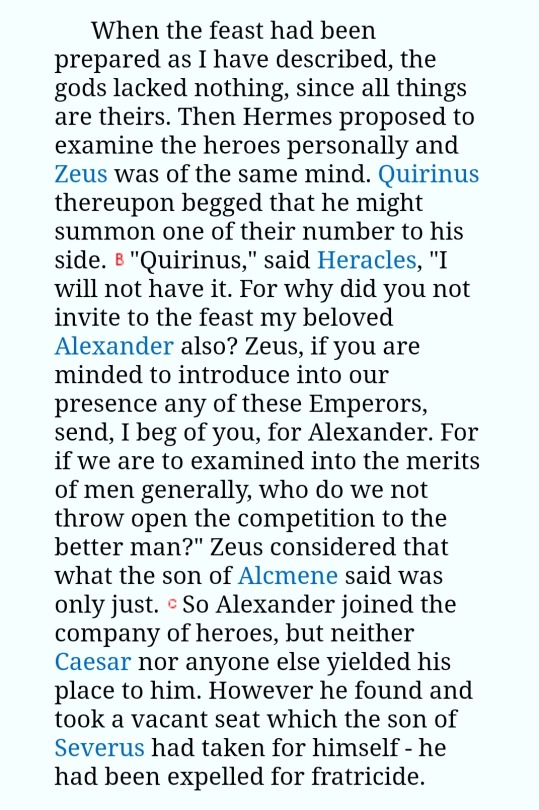
Like, "my beloved Alexander"?? It's cute when the gods gush over their mortal descendants.
Now, a shoutout to the emperors who didn't even get a chance to sit in the assembly because they were the worst of the lot apparently. We have:
Caligula, so terrible that the gods didn't wanna even look at him and he straight away was sent to Tartarus
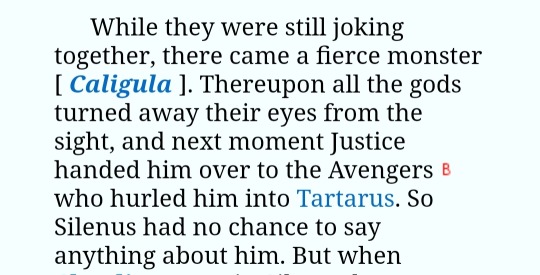
Nero, who tried to be an Apollo wannabe and promptly got taken to the underworld

Commodus, whom Silenus didn't even bother to roast (and he tripped and fell anyway, what a loser)

There are more but these were the funniest
Anyway, the gods decide on how to choose the best amongst the Emperors. Apollo and Hermes have differing opinions on this, but Zeus decides to entertain the suggestions of both of his sons :3 (finally, one instance where he treats Apollo and Hermes equally)

All the emperors talk about their achievements first, then Hermes cross examines them to see if their motives were worthy enough and oh boy, it does not go well for Alexander who is brought to the verge of tears by Dionysus lmaooo

Anyway, in the end the gods vote and Emperor Marcus Aurelius wins the contest. But after that, Zeus asks each emperor to choose a god to spend the rest of their evening with

Ares and Aphrodite kind of just adopt Caesar LOL and yes, Cronus is present, sitting beside Zeus, with Rhea and Hera also sitting with them. He is the one who nominates Marcus Aurelius.
but here's the most crack part of this whole thing:
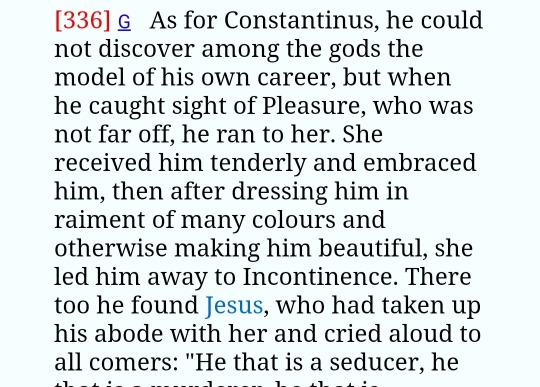
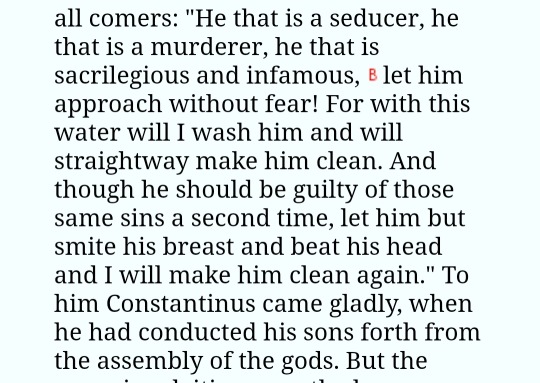
Like who invited Jesus bro skdjsndn 😭
Anyway, the story ends with Hermes giving some generic advice to the author, Emperor Julian and ending the story. Also, Julian lets us know that this whole story was told to him by none other than Hermes himself, and gives a disclaimer that he doesn't know if it's is true or just a lie fabricated by Hermes, or a mixture of both LMAO
Here's the link PLEASE READ THE ENTIRE THING
#Kronos#Zeus#Dionysus#Silenus#Apollo#Hermes#some jokes and roasts I did not understand because I am really not well versed with these emperors#and the many atrocities they've committed#but this made me more interested in digging into the Roman empire than anything else#Like Heliogabalus?#Absolute madlad#I should have known about him sooner#Anyway#Even if you just like seeing Greek gods hang out and have a nice family chat#You will really enjoy this#Emperor Julian#The Caesars
45 notes
·
View notes
Text
The Dionysos gallery (2)
Next on our travel down the Dionysos museum, we have an entire section dedicated to the Bacchanals in painting - with a few analysis here and there.
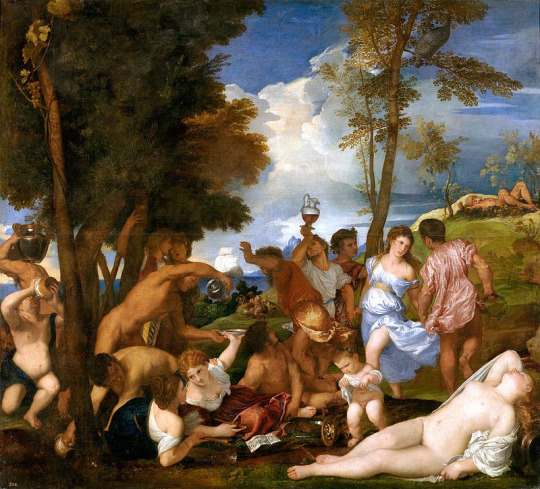
Titien's The Bacchanal of the Andrians
The Museum's website adds that this depicts the legend of how Dionysos gifted the inhabitants of the island of Andros with a river of wine. It was one of the numerous "miracles" attributed to the god by folk-belief when he became the god of the grapevine. Already in his "Bacchants" Euripides had told how, by touching a stone with his thyrsus he created a stream of fresh water, and where his narthex had touched the ground a stream of wine flowed ; and those that sought milk only had to scratch the ground near the god to see it flow, and from the god's thyrsus honey dropped...
In Ionia, on the island of Teos, a similar legend existed: it was said, by Diodor of Sicily and Pline the Elder, that at a fixed date in a calendar a stream of wine regularly flowed. At Elis, on the eve of the god's feast-day, empty jars and jugs were sealed and left alone in Dionysos' temple: by the morning, when they were opened, they were filled to the brim with wine.

Giovanni Bellini and Titien's The Feast of the Gods
The museum adds this mention: the painting is a depiction of the legend of Lotis collected by Ovid. One night, as the gods had a feast, the nymph Lotis fell asleep. Priapus got close to her, and with his famous ithyphallic nature, he decided to rape her. But as he was about to touch her body, the donkey of Silenus started making loud noises - waking up everybody, including Lotis. Lotis fled from Priapus' embrace, and all the gods laughed and mocked the god.
This painting was most notably the favorite painting of Fernand Botero.

Dosso Dossi's Bacchanal with a drunk Silenus and Bacchants frolicking around grapevine
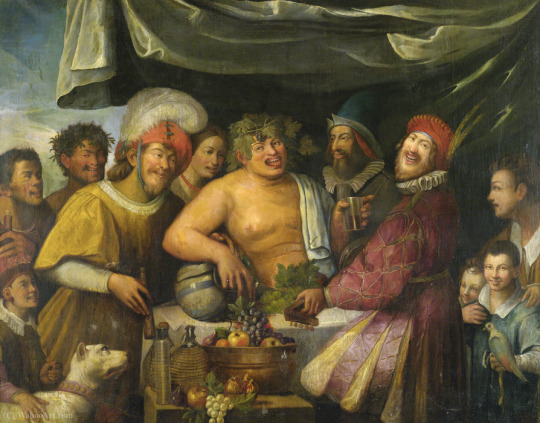
Niccolo Frangipane's Bacchanal

Nicolas Poussin's Bacchanal

Nicolas Poussin's Bacchanal with a guitar player ; also called "Great Bacchanal"
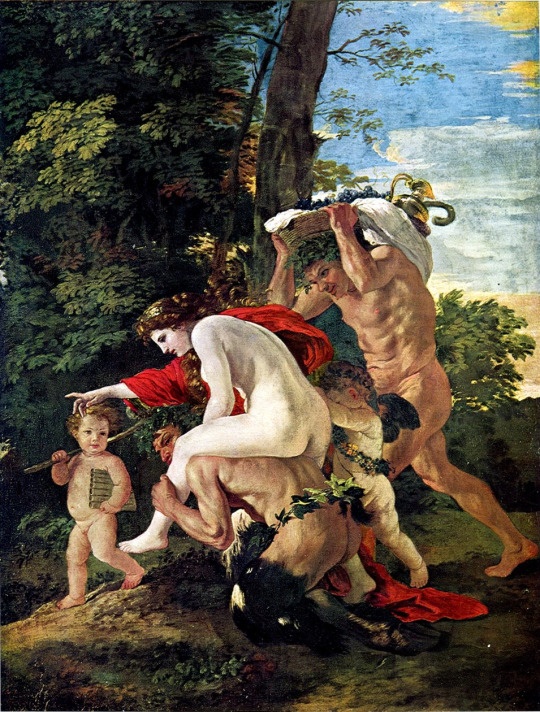
Nicolas Poussin's Bacchic Scene

Pier Francesco Mola's Bacchus supervising the Satyrs pressing wine

Gerrit van Bronckhorst's Bacchanal with Silenus
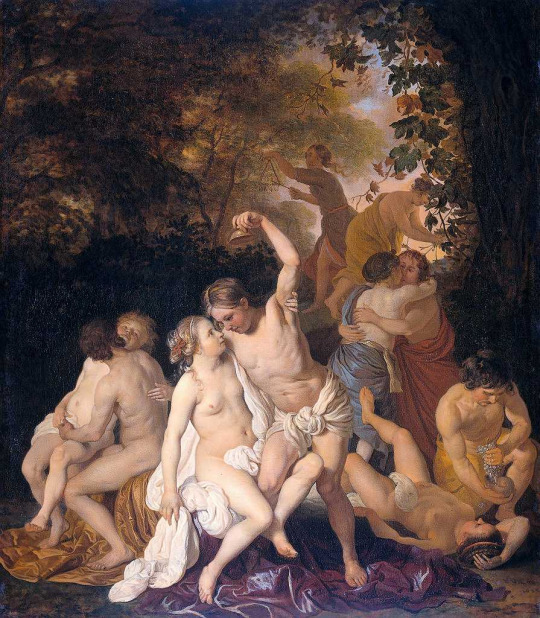
Jacob van Loo's Scene with Bacchants

Michaelina Wautier's Bacchanal
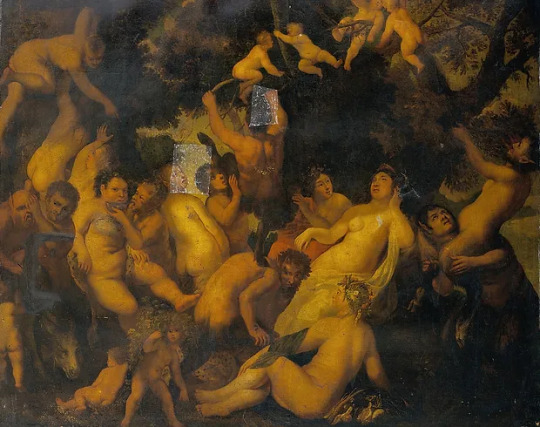
Jacques Jordaens' Bacchanal
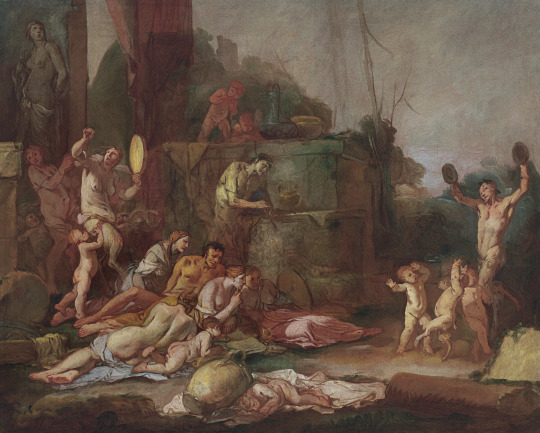
Giulio Carpioni's Bacchanal

Michel-Ange Houasse's Bacchanal
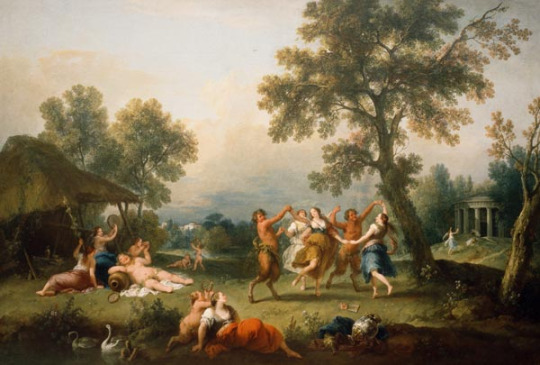
Francesco Zuccarelli's Bacchanal
#dionysos#the art of the myth#dionysus#bacchanal#the dionysos gallery#silenus#bacchants#greek mythology#painting#art
39 notes
·
View notes
Text
in greek mythology, dionysus’ closest companion, and the one most revered by mortals, was silenus, a satyr known for constantly drinking to the point of being so drunk he had to be carried around from place to place, the wine bottle never leaving his grasp. imagine, silenus, with his huge, round, wine filled belly sloshing as the other satyrs, less drunk but only just, struggle under his weight and try to parade him around, hiccupping and belching through wine-sweet crooning. the satyrs finally have to take a break, and they gracelessly let silenus fall to the ground before whipping out their own bottles and flasks and joining their idol on the ground. silenus barely notices they’re not moving anymore, continuing his crooning, and chugging down wine until he topples over onto the other satyrs, who of course help him hold the bottle to his lips, just a giant tangle of wobbling drunken happy fatties. imagine you, mortal, watching this scene unfold with longing and desire burning in you and deciding to approach them. when you get close, silenus notices you and leers lopsidedly, thrusting his bottle out, leaving you no choice but to take it. the minute the wine touches your lips, you can’t help but tip the whole thing back, sending sweet strong wine rushing down your throat until you’re licking the rim for any last drop. you too, collapse down, joining the pile of drunkards, smiling as you accept another bottle, and then another, and then another, and then you are indistinguishable from the rest of silenus’ band, tottering drunk with a bulging sloshing belly, supporting the weight of your leader, spreading merriment and drunkenness wherever you go.
#intox#intox k1nk#intox feedism#belly kink#beer belly#wg text#wine#wine drunk#satyr#silenus#fat belly#chub kink#mind break#dumbification#drinking#intoxication kink#intox belly
59 notes
·
View notes
Text





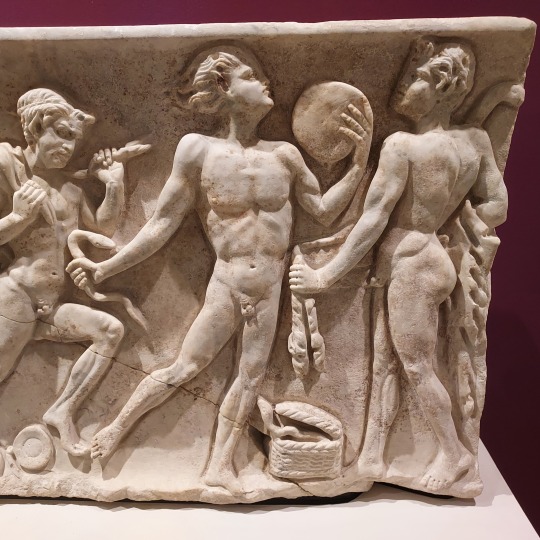
Sarcophagus
2nd century AD
Marble
Roman
------------------------------------------
Sarcophagus with a Bacchic triumph.
Featuring: Ariadne, Bacchus (Dionysus), Maenad, Centaurs, Silenus (Papposilenus), Satyrs
Located at the Kelsey Museum of Archaeology
#artifacts#ancient rome#Sarcophagus#Bacchus#Dionysus#Silenus#Ariadne#maenad#centaur#satyr#Kelsey Museum of Archaeology#here for a good time not a long time
82 notes
·
View notes
Text

Peter Paul Rubens - The Drunken Silenus (ca. 1618-1625)
36 notes
·
View notes
Text


Museo Archeologico Nazionale di Napoli
Photo by Charles Reeza
26 notes
·
View notes
Photo
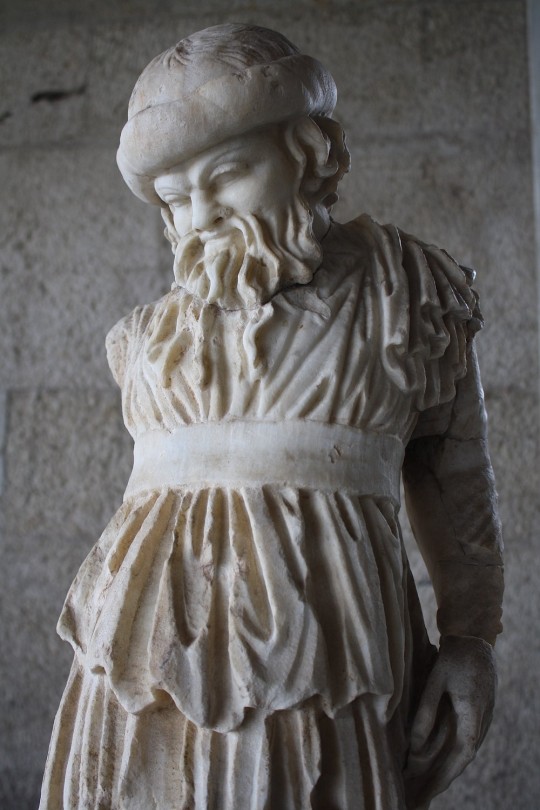
Silenus
Silenus (also spelt Silenos) is a rustic god of the forest, drunkenness and wine-making in Greek mythology. He is best known as the companion and foster father of the god Dionysos. Silenus is closely associated with the satyrs, sometimes listed as the oldest and the wisest satyr.
Continue reading...
53 notes
·
View notes
Text

~ Lying Silen.
Date: first half of the A.D. 2nd century
Medium: White marble
Provinience: Ravenna, National Museum (Museo nazionale di Ravenna).
#ancient#ancient art#history#museum#archeology#ancient sculpture#ancient history#archaeology#lying silen#silen#silenus#white marble#2nd century
382 notes
·
View notes
Text
Before her hatred rises up the wild, handsome figure of the zealot faun, whom they call the Preacher of the Wilderness.
Adonis!
Within her, a rage of Venus finds its own justification.
— Peter Hille, The Dedalus Book of German Decadence: Voices of the Abyss, transl by Ray Furness and Mike Mitchell, (1994)
#German#Peter Hille#The Dedalus Book of German Decadence: Voices of the Abyss#Ray Furness#Mike Mitchell#(1994)#Silenus#John the Baptist#Adonis#Venus#Aphrodite
6 notes
·
View notes
Text

Terracotta antefix with head of a Satyr or Silenus from the 6th century BCE. The figures seem to be drunk and to yell or speak loudly, as these figures were strongly connected with the cult of Dionysus the god of wine and associated with fertility from the collection of the archaeological museum of Tinos
#philosophy#art#terracotta#sculpture#ancient greece#greece#history#archaeology#tinos#satyr#silenus#dionysus
83 notes
·
View notes
Text
Body Fat in Greco-Roman Antiquity (transcribed article)
A long time ago I made a post about the depictions of Dionysos/Dionysus/Bacchus as fat. You can read it here if you want - but that was just me going on about stuff taken left and right, nothing too serious, just thoughts.
I want to bring you today a serious article about the perception of the fat body in Ancient Greece and Ancient Rome. This article is actually a page hosted on "Google Arts and Culture", titled "In the Flesh: Body Fat in Ancient Art". It was created by the J. Paul Getty Museum, and you can read it all here. But the website has a really specific design that makes it hard for some people to read the page, so I thought why not help share it around by copying it below. Of course, nothing belongs to me, I am just transcribing it all (plus copying the images). All credits go to the J. Paul Getty Museum.
In the Flesh: Body Fat in Ancient Art
Ancient Greek and Roman writers criticized bodies of different sizes for a variety of reasons. But in works of art, body fat was often depicted in ways that defy our expectations.
A Different Ideal
Terms like "overweight" and "underweight" originate in modern medicine's concept of an ideal body weight. Calculated to minimize mortality risk, this medically desirable weight varies based on such factors as height, age, and fitness.
Ancient Greeks and Romans compared the appearance of their bodies with respect to a more abstract ideal.
For the ancient physician Galen, measurements for the ideal body were expressed centuries earlier in the Canon, a treatise on statue proportions by the 5th-century BC sculptor Polykleitos:
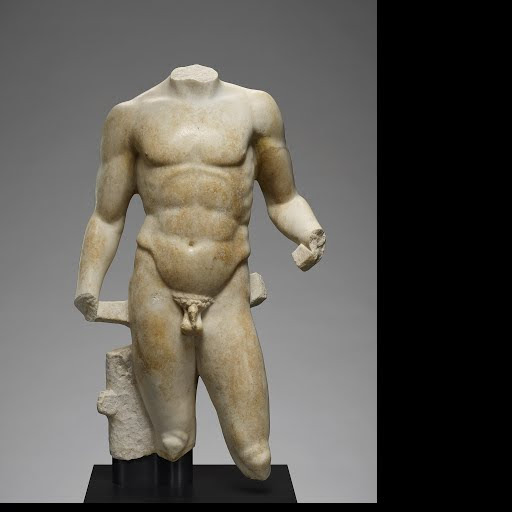
(Male torso, about A.D. 100, Unknown)
"[Neither the overweight nor the underweight body] is in due proportion. But the body which equals the Canon of Polykleitos reaches the summit of complete symmetry."
— Galen, Ars Medica K 343
For the ancient Greeks, precisely measured weight was less important than the perception of symmetry and balance.
They had a term for this desirable state of wellness: εὔσαρκος (eusarkos), meaning "well-fleshed" or "fleshy."
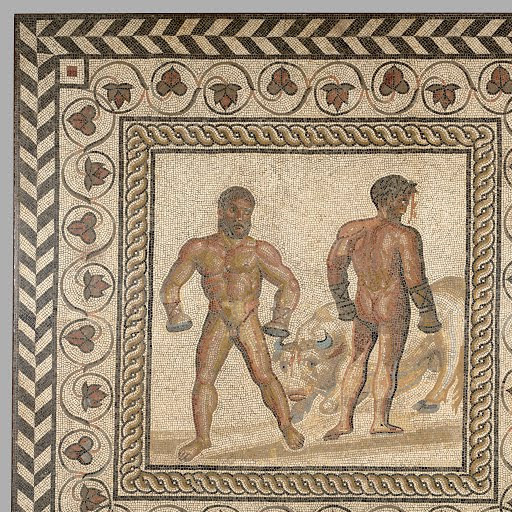
(Mosaic floor with combat between Dares and Entellus, A.D. 175-200, Unknown)
Because the Greeks prized moderation in all things, bodies or behaviors that stood out from this ideal were targets of criticism. Perhaps surprisingly, this criticism also applied to muscular athletes, such as wrestlers and boxers, who required constant high-calorie diets.
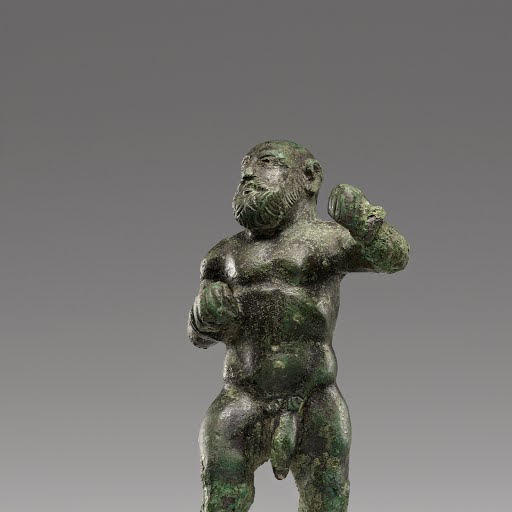
(Statuette of a boxer, unknown)
Big Bodies in Comedy
Mockery of those who ate more or less than necessary was one way to impose social compliance and maintain political order.

(Apulian red-figure bell krater, 370-360 BCE, Cotugno painter)
Many Greek and South Italian vases often depict comic actors wearing "fat suits" (as well as a mask and a phallus) to embody popular character types.
Actors used such props as comic gags, and vase painters often represented them with great care.

On this Apulian mixing bowl, lines extending across the actor's chest make clear that his large, sagging breasts are artificial. His belly is unnaturally circular and hangs too low — further evidence that he is wearing a costume.
It seems that the painter wanted to pointedly emphasize the exaggerated nature of such costumes.
Ample Satyrs
Not all depictions of larger bodies were mocking. Animal ears and the double flute identify this figure as a satyr, or a woodland deity. He reclines in a pose that would remind viewers of the satyrs' master, the wine god Dionsyos, who is often depicted reclining at a banquet.
Instead of on a fancy couch, the chubby old satyr rests on a full wineskin!

(Fragment of an Apulian squat Lekythos, 350-325 BC, Darius painter)
Under tufts of gray hair, lines accentuate the curving folds of the old satyr's body. Unlike the ridiculously artificial bodies of the padded actors, the satyr's big, hairy body is gentle and soft.
Like the plump pillow on which he rests, the satyr appears comfortable and at ease. This scene is meant to be lighthearted, and does not appear cruel or mocking.
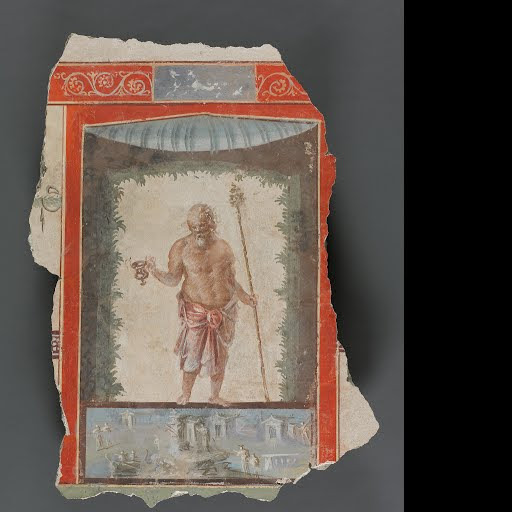
(Fresco fragment depicting an old Silenos with kantharos and thyrsos, AD 1-79, Unknown)
Similar attention to detail can be seen in this Roman wall painting of the old satyr Silenus. The painter’s skillful use of red shadows and pink highlights builds up the volume of his chest and stomach, which appear both soft and sturdy at the same time.
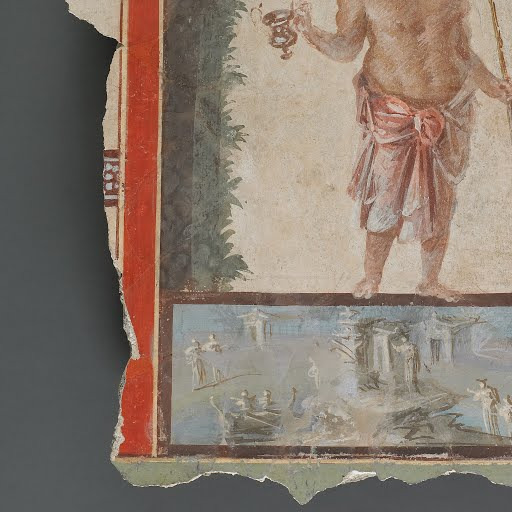
These fleshly older satyrs were symbols of pleasure-seeking and leisure.
Fragile Bodies on the Margins
Skinny or underweight bodies were also criticized, in part because of the association between emaciation and illness. Thinness could also negatively reflect on one's character.

(Miniature skeleton, unknown)
Ancient authors often noted a person's skinny frame as a way of pointing out their intellectual or social irrelevance.
The association of thinness and powerlessness is sometimes exploited in representations of enslaved individuals, domestic servants, and those otherwise marginalized in society.

(Finial with a resting youth, unknown)
On this figurine of a resting youth, the individually shaped ribs might suggest that the figure is undernourished.

In depictions of older individuals, such as this statuette of an old woman, underweight features are often used to indicate frailty.

(Statuette of an old woman, 100-001 BCE)
Such subjects were popular in the Hellenistic period (c. 330-31 BC) —a time of unprecedented social inequality — and consciously aestheticized:
"When we see emaciated people we are distressed, but we look upon statues and paintings of them with pleasure, because imitation, as such, is attractive to the mind's nature."
- Plutarch, Quaestiones convivales 5.1.
Size and Gender
Body fat was also linked to gender, especially in the Roman Empire. While bodies of women were routinely criticized by Roman authors, fluctuation in weight did not render them less feminine. By contrast, both fat and skinny men were explicitly mocked as effeminate, lacking either physical strength or stamina.
Biographies of unpopular Roman emperors often weaponize their body size in this way. Of the emperor Galba, the biographer Suetonius writes, "it is said that he was a heavy eater," immediately before turning to rumors about his inclinations towards "unnatural desires."
Such fat-shaming seems not to have mattered to the emperors themselves. Their official portraits show little concern for concealing the fullness of their faces.
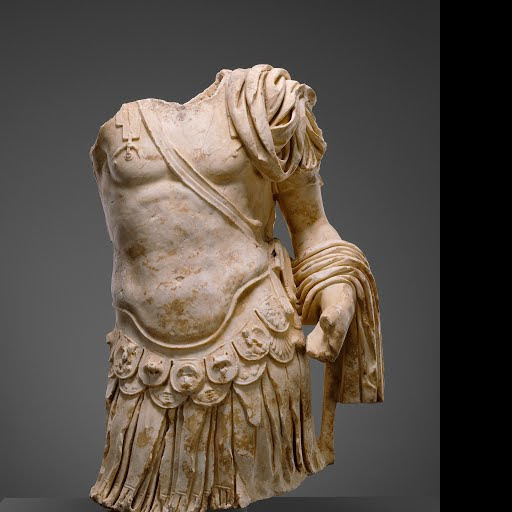
(Torso of a cuirassed statue, unknown)
The situation may have been different in military affairs. The anxieties Roman men felt about their bodies can be seen in their choice of armor. Their bronze breastplates were decorated with chiseled pectorals and washboard abs, creating the illusion of a skin-tight fit.
It is unlikely that such breastplates were meant to deceive, any more than the fat suits of comic actors. What they offered to their wearers was the illusion of inhabiting — for a moment — the ideal body of a Polykleitan statue.
Divine Softness
A closer look at ancient art reveals that the bodies of gods were sometimes less harshly judged than those of mortals.
Depictions of certain gods regularly focus on the softer parts of their bodies.
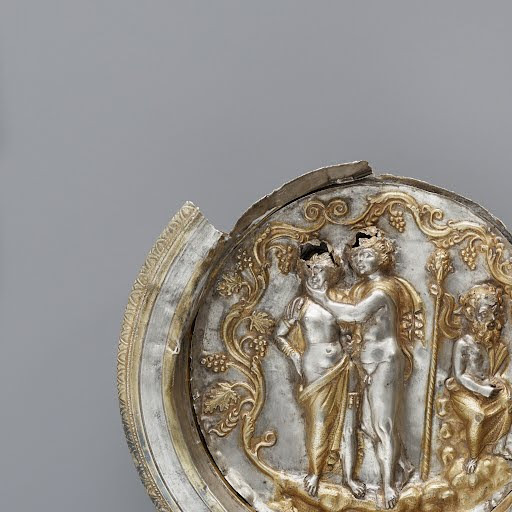
(Bowl with a medallion depicting Dionysos and Ariadne, unknown artist, -100)
The maker of this Hellenistic silver medallion went out of their way to show the curvy bodies of the wine god Dionysus and his wife Ariadne, engraving lines under their bellies to highlight the sensuality of their encounter.
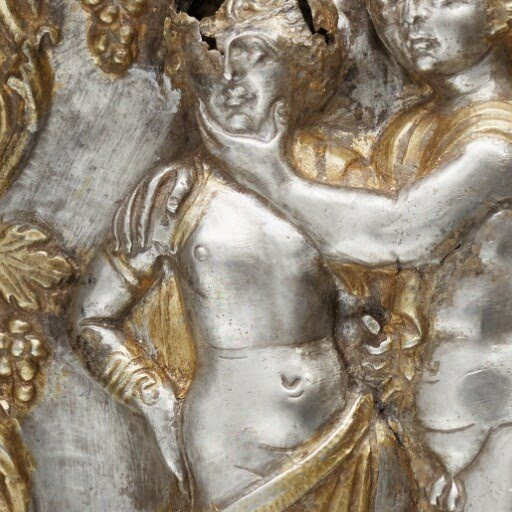
Some popular representations of the love goddess Venus, such as the so-called "Crouching Venus" type, unquestionably emphasize the fleshiness of her body.

Statue of a Crouching Venus Statue of a Crouching Venus, Unknown, A.D. 100–150, Provenant de la collection : The J. Paul Getty Museum
Modern observers have highlighted the positive associations between fleshiness and fertility expressed by a variety of Greek and Roman authors, but there is more to the story.
The rolls of flesh on the goddess's belly also gave the ancient sculptor a means of creating a very intimate encounter between viewer and goddess.
To ancient viewers of all ages and genders, accustomed to seeing gods represented solemn and upright, the crouching pose allowed a glimpse into the goddess's private world.
The crouching goddess seemed more approachable to worshippers, in part because her body moved in ways they could recognize from their own lived experience. The softness of Venus’s body made the cold, hard marble come to life.
#ancient greece#ancient rome#body positivity#fatphobia#greek gods#body fat#venus#dionysus#dionysos#ariadne#roman emperors#satyrs#underweight#satyr#silenus#ancient art#ancient greek art#body types#art#weight#ancient greek society#roman empire
21 notes
·
View notes
Text
While studying my greek history class i had a thought: Victor Hugo!Grantaire might be representing the figure of Silenus. im sure someone already thought that but.
they drink a lot
they follow Dionysus' cortege
they are very ugly
they are "bon vivant" (as we say in french), always laughing and singing
minor divinity of drunkenness, always in this state
but there's also a part of them as prophet, wise and philosoph
Also my teacher said Silenus were, for the Greeks, an intermediate between "civilized world" and "barbaric world". Ancient Greeks built their identity by differentiating themselves of the "barbarians" through the way they drink wine (a very important drink in their culture). "Civilized people" (the Greeks, especially the political and social elite) drank wine moderatly, in opposition of "barbarians" (or lower classes) who were in excess, hybris. Maybe there's some symbolic things to say about Grantaire here, especially when we know that Victor Hugo sometimes talk about "barbary"("savage") and "civilization" (ex: last paragraphs of les mis, volume IV, book 1, chap. 5)
#grantaire#les miserables#les mis#greek mythology#greek history#silenus#victor hugo#i never post here so be kind#going back to study because i wont have my diploma if i keep thinking about analyzing old books
10 notes
·
View notes
Photo



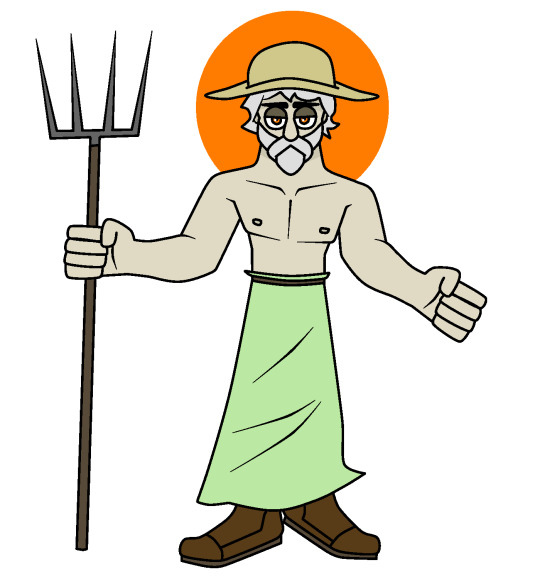
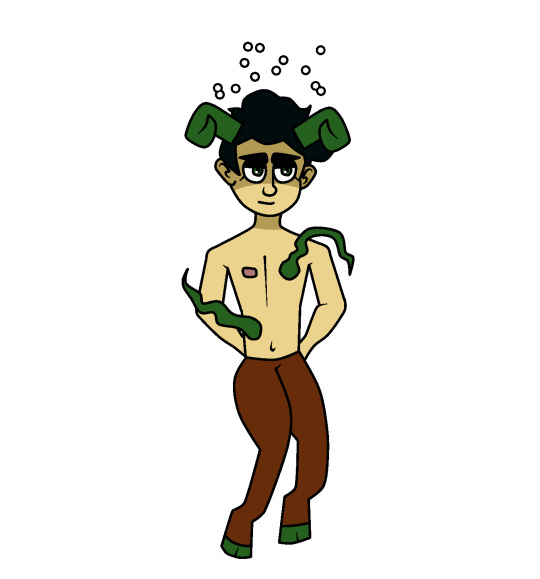


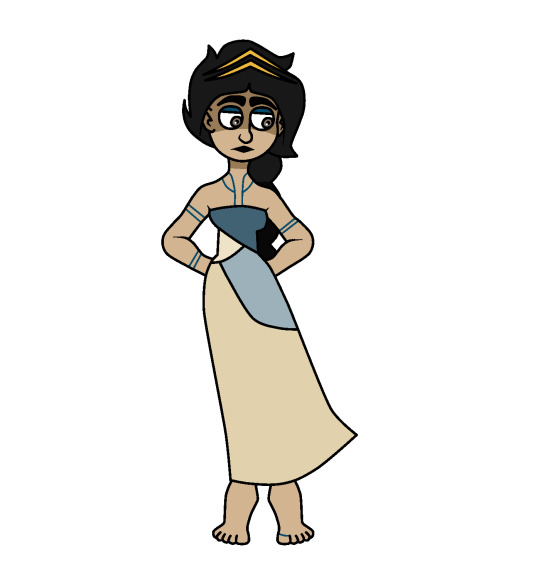


Dionysian Figures:
SEMELE / DIONYSUS / ARIADNE
PRIAPUS / AMPELUS / SILENUS
ACRATUS / TELETE / MARON
Based off midjourney ai art
#Dionysus#Dionysos#dionysian#dionysus god#dionysus x ariadne#ariadne#semele#maron#silenus#priapus#telete#thyone#thyrsus#acratopotes#acratus#ampelus#hellenic polytheism#hellenism#hellenic pagan#pagan#Greek#Greek Mythology#greek gods#Greek Pantheon#paganism#paganblr
39 notes
·
View notes
Photo

Anthony van Dyck - Drunken Silenus (c. 1619 - 1620)
36 notes
·
View notes